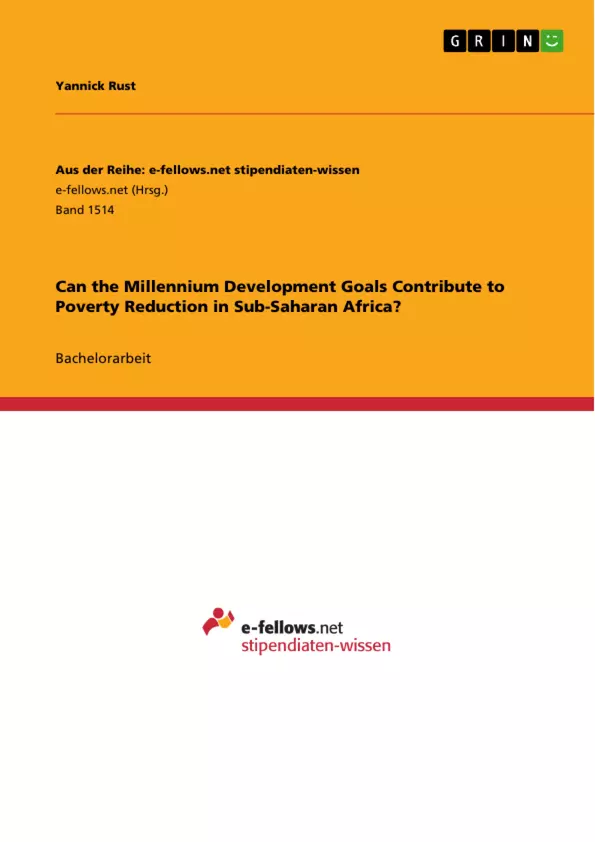On the basis of this prediction this paper will assess whether the United Nations´ development agenda – the Millennium Development Goals – could provide a pathway in achieving this keen target and herald an era of bold ambition to solve one of the world´s most urging problems.
The MDGs comprise eight global objectives, one of them “The eradication of worldwide poverty”, which is being measured by a set of economic indicators in order to derive respective strategies for halving destitution between 1990 and 2015. In the course of this work the success and shortfall of the implemented strategies will be analyzed for Sub – Saharan Africa, the region where the greatest share of the world´s poor reside. Furthermore, the chances and deficits that global development agenda such as the MDGs exhibit will be taken into deeper consideration highlighting the needs of the development assistance of the years to come.
Ultimately, the future efforts of international institutions, governments and nongovernmental organizations with reference to poverty alleviation will be outlined and evaluated as far as Mr. Kim´s statement of ending poverty within a generation can be realized.
Inhaltsverzeichnis
- Abstract
- List of abbreviations
- Introduction
- 1 – The Millennium Development Goals
- 1.1 – Relevance of the MDGs
- 1.2 - Focus on MDG No. 1: Eradication of worldwide poverty and hunger
- 2 - Poverty in Sub-Saharan Africa
- 2.1 Overall assessment of the poverty situation in Sub-Saharan Africa
- 2.2 – Characteristics of poverty in the Sub-Saharan region
- 3- The United Nations strategic approach to reduce poverty: The use of employed indicators and their limitations
- 3.1 – Target No. 1: “Halve the proportion of people whose income is below US$1.25 PPP a day”
- 3.2 - Target No. 2: “Achieve full employment and decent work for all”
- 3.3 Critical consideration of the indicators employed
- 4 - Development strategies derived from the employed ratios
- 4.1 – Strategies targeting poverty alleviation
- 4.1.1 – Investments in social safety nets
- 4.1.2 Direct cash transfers
- 4.1.3 Zero-interest development grants
- 4.2 – Strategies targeting employment creation
- 4.2.1 Investing in agriculture
- 4.2.2 - Investing in infrastructure
- 4.2.3 – Investing in human capital
- 4.1 – Strategies targeting poverty alleviation
- 5 - Success evaluation of the poverty - reduction strategies
- 5.1 – Evaluation of strategies targeting poverty alleviation
- 5.1.1 – Investing in social safety nets
- 5.1.2 Direct cash transfers
- 5.1.3 Zero-interest development funding
- 5.2 - Evaluation of strategies sustaining employment creation
- 5.2.1 Investing in agricultural productivity
- 5.2.2 Investing in infrastructure
- 5.2.3 Investing in human capital
- 5.3 Critical consideration of the evaluated strategies
- 5.1 – Evaluation of strategies targeting poverty alleviation
- 6 – Investment needs and sources of funding to reach MDG No.1
- 6.1 Investment needs
- 6.1.1-Top-Down-Approach
- 6.1.2 Bottom-up-Approach
- 6.2 Sources of funding
- 6.1 Investment needs
- 7 – Alternative strategies of poverty alleviation and development financing
- 7.1 – Investing in Information and Communication Technologies
- 7.2 Global taxes
- 7.3 – International Finance Facility for Immunization (IFFIm)
- 8 - Outlook for 2015 and the future development agendas
- 8.1 - The Post - Agenda
- 8.2 - The MDGs as benchmark for future development efforts
- 8.3 Limitations of global goal – setting
Zielsetzung und Themenschwerpunkte
Diese Arbeit untersucht die Wirksamkeit der Millenniums-Entwicklungsziele (MDGs) bei der Armutsbekämpfung in Subsahara-Afrika. Sie analysiert die Relevanz der MDGs im Kontext der globalen Armutsbekämpfung und konzentriert sich insbesondere auf das Ziel der Armutsbeseitigung (MDG No. 1). Die Arbeit beleuchtet die spezifischen Herausforderungen der Armut in Subsahara-Afrika und untersucht den strategischen Ansatz der Vereinten Nationen zur Armutsreduktion, einschließlich der verwendeten Indikatoren und deren Grenzen.
- Die Relevanz und Wirksamkeit der Millenniums-Entwicklungsziele zur Armutsbekämpfung
- Die Herausforderungen der Armut in Subsahara-Afrika
- Die Strategien der Vereinten Nationen zur Armutsreduktion und deren Bewertung
- Die Investitionsbedarfe und Finanzierungsquellen zur Erreichung des MDG No. 1
- Alternative Strategien zur Armutsbekämpfung und Entwicklungsfinanzierung
Zusammenfassung der Kapitel
- Kapitel 1: Dieses Kapitel stellt die Millenniums-Entwicklungsziele (MDGs) vor und erläutert deren Relevanz für die globale Armutsbekämpfung. Es konzentriert sich auf das Ziel der Armutsbeseitigung (MDG No. 1) und die verwendeten Indikatoren.
- Kapitel 2: Dieses Kapitel analysiert die Armutssituation in Subsahara-Afrika und beleuchtet die spezifischen Herausforderungen der Region.
- Kapitel 3: Dieses Kapitel untersucht den strategischen Ansatz der Vereinten Nationen zur Armutsreduktion und analysiert die verwendeten Indikatoren und deren Grenzen.
- Kapitel 4: Dieses Kapitel untersucht die Entwicklungsstrategien, die aus den verwendeten Indikatoren abgeleitet wurden, und konzentriert sich auf Strategien zur Armutsbekämpfung und zur Schaffung von Arbeitsplätzen.
- Kapitel 5: Dieses Kapitel bewertet den Erfolg der Strategien zur Armutsbekämpfung und zur Schaffung von Arbeitsplätzen, die in Subsahara-Afrika umgesetzt wurden.
- Kapitel 6: Dieses Kapitel untersucht die Investitionsbedarfe und Finanzierungsquellen, die erforderlich sind, um das MDG No. 1 zu erreichen.
- Kapitel 7: Dieses Kapitel stellt alternative Strategien zur Armutsbekämpfung und Entwicklungsfinanzierung vor, wie z. B. Investitionen in Informations- und Kommunikationstechnologien, globale Steuern und die Internationale Finanzierungsfazilität für Immunisierung (IFFIm).
Schlüsselwörter
Die Arbeit befasst sich mit den Themen Armutsbekämpfung, Millenniums-Entwicklungsziele (MDGs), Subsahara-Afrika, Entwicklungsstrategien, Investitionsbedarfe, Finanzierungsquellen, alternative Strategien, Informations- und Kommunikationstechnologien, globale Steuern, Internationale Finanzierungsfazilität für Immunisierung (IFFIm).
- Arbeit zitieren
- Yannick Rust (Autor:in), 2015, Can the Millennium Development Goals Contribute to Poverty Reduction in Sub-Saharan Africa?, München, GRIN Verlag, https://www.grin.com/document/303108



